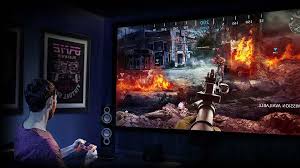
Video games have come quite a long way from simple games and simulations made for computers and arcades. Now we have thousand dollar gaming systems, Twitch streamers, and world-wide gaming competitions. With such a large and fast-growing industry, it’s no surprise that we’re constantly finding new ways to experience our favorite video games. One of these ways is by playing them on a huge projector screen. In fact, it’s become so prevalent that brands now make projectors that are specifically designed with gamers in mind. The much larger screen size will make you feel like you’re in a virtual reality, while also making it a lot easier to play split screen games with friends. Another benefit of these gaming projectors is they are designed to connect easily to most devices, and are optimized for fast performance, because nobody likes a laggy video game.
Input Lag
Most gamers would agree that nothing is more frustrating than a glitchy and unresponsive game. Many multiplayer games require you to make split-second decisions, and if your game isn’t moving as fast as you are, you could easily lose a life. The way that gaming projectors combat this is by improving their response time and refresh rate. These factors aren’t as much of a priority in other types of projectors.

Response Time
The response time is a measure of how long it takes for the projector to register on the screen which button you clicked on your controller, and it’s measured in milliseconds (ms). This is one of the main details that manufacturers focus on when making a projector that’s optimized for gaming. For example, the Optoma UHD38 has a response time of just 16ms and it features an enhanced gaming mode that reduces the lag to a mere 4.2ms. With a lag time that’s basically non-existent, this projector is a great choice for every type of game, from sports, to racing, to first-person shooters like Call of Duty. The Optoma UHD38 uses a BL-FU240E replacement lamp, and here’s a few helpful tips if you’re not sure how often you need to change your lamp.
Refresh Rate

The refresh rate of a projector refers to the number of times a monitor updates the entire frame each second, it’s measured in hertz (Hz) or frames per second (fps). Here, you want to look for the highest number, which is opposite of the response time where you want the lowest. Due to ever-advancing technologies, there are now some projectors, like the Epson EH-TW9100 , that have a whopping refresh rate of 480Hz, which is a huge leap from the previously accepted rate of just 60Hz.
Throw Distance

When it comes to gaming projectors, short throw projectors have a couple major advantages over long throw ones, since they can be placed closer to the screen. For starters, they eliminate the super annoying issue of people walking in front of your projector and creating shadows on the screen, which can be really problematic in the middle of a game. Also, they don’t need as much space as long throw projectors so they’re better for use in small areas like bedrooms, which is where many people enjoy playing video games. The Optoma GT1080HDR is a great choice for a short throw gaming projector, with the ability to project images up to 100″ from only 3 feet away.
Brightness

If you crave the most immersive video game experience, then the brightness of your projector should also be a deciding factor for you. Since games nowadays have such high-quality graphics, you’re missing out if you don’t get to see them in their true color. If you plan on playing in a pitch black room, like a basement, then you won’t need to worry about this aspect too much. However, if you prefer to play video games in a room with ambient light, such as a living room, you’ll need more lumens to be able to see everything the game has to offer. In these situations, you’ll need a projector with at least 2,000 lumens. However, something like the BenQ TK800M that features a lumen count of 3,000 will provide you with such bright displays that you could play in even the most well-lit areas.

Resolution
Another thing to keep in mind is that, even though gaming projectors have improved tremendously, they haven’t yet been able to perfect the ability to have the highest resolution while simultaneously having the lowest refresh rate, even with the best gaming projectors, like the BenQ TK700STi. This projector is able to display ultra high-def 4k but with a significantly more lag at 60Hz at 16ms, or you could choose to view with a slightly lower resolution of 1080p but a super low lag time of just 4ms and 240Hz. So, while playing you’ll have to choose your game mode based on whether it’s more important for you to enjoy the most seamless gameplay or the highest quality graphics.

Audio
Lastly, for added convenience, and to save money on a speaker system, you might want to look for a projector with built-in speakers. Many projectors now have the helpful feature of built-in speakers that can go all the way up to 10 watts, which might not be surround sound quality per se, but they’ll definitely get the job done. The BenQ HT2050A projector is a great example of a gaming projector with a 10 watt speaker. For an even better built-in audio experience (at a slightly higher price), some projectors feature 2 speakers, like the BenQ HT2150ST.
Now, this is not to say that these projectors won’t also make a great choice for tons of other uses like outdoor movie nights, or DIY projects, but for dedicated gamers, you can greatly enhance your experience by understanding the benefits of projectors made specifically for gaming purposes. Hopefully now that you know what to look for, you’ll have an easier time shopping for your projector. Good luck on your search and as always, thank you for shopping with us!
For all of your replacement lamp needs, visit https://www.purelandsupply.com/, your source for replacement projector lamps.

